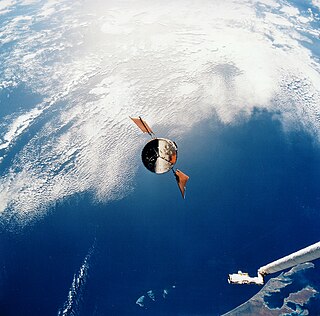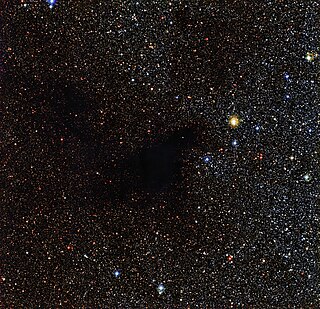Related Research Articles

Apparent magnitude is a measure of the brightness of a star or other astronomical object. An object's apparent magnitude depends on its intrinsic luminosity, its distance, and any extinction of the object's light caused by interstellar dust along the line of sight to the observer.

The Very Large Telescope (VLT) is a facility operated by the European Southern Observatory, located on Cerro Paranal in the Atacama Desert of northern Chile. It consists of four individual telescopes, each equipped with a primary mirror that measures 8.2 meters in diameter. These optical telescopes, named Antu, Kueyen, Melipal, and Yepun, are generally used separately but can be combined to achieve a very high angular resolution. The VLT array is also complemented by four movable Auxiliary Telescopes (ATs) with 1.8-meter apertures.

Photometry, from Greek photo- ("light") and -metry ("measure"), is a technique used in astronomy that is concerned with measuring the flux or intensity of light radiated by astronomical objects. This light is measured through a telescope using a photometer, often made using electronic devices such as a CCD photometer or a photoelectric photometer that converts light into an electric current by the photoelectric effect. When calibrated against standard stars of known intensity and colour, photometers can measure the brightness or apparent magnitude of celestial objects.

Observational astronomy is a division of astronomy that is concerned with recording data about the observable universe, in contrast with theoretical astronomy, which is mainly concerned with calculating the measurable implications of physical models. It is the practice and study of observing celestial objects with the use of telescopes and other astronomical instruments.

NASA's series of Great Observatories satellites are four large, powerful space-based astronomical telescopes launched between 1990 and 2003. They were built with different technology to examine specific wavelength/energy regions of the electromagnetic spectrum: gamma rays, X-rays, visible and ultraviolet light, and infrared light.

The High Speed Photometer (HSP) is a scientific instrument formerly installed on the Hubble Space Telescope. The HSP was designed to measure the brightness and polarity of rapidly varying celestial objects. It could observe in ultraviolet, visible light, and near infrared at a rate of one measurement per 10 microseconds. The design was novel in that despite being able to view through a variety of filters and apertures, it had no moving parts "except for electrons" as principal investigator Prof. Robert Bless was fond of saying. Filter and aperture selection was accomplished using image dissector tubes and the HST pointing system. It was functional from launch in 1990 until it was removed at the end of 1993, and it helped diagnose an issue with the Hubble's primary mirror.

Neil Gehrels Swift Observatory, previously called the Swift Gamma-Ray Burst Explorer, is a NASA three-telescope space observatory for studying gamma-ray bursts (GRBs) and monitoring the afterglow in X-ray, and UV/Visible light at the location of a burst. It was launched on 20 November 2004, aboard a Delta II launch vehicle. Headed by principal investigator Neil Gehrels until his death in February 2017, the mission was developed in a joint partnership between Goddard Space Flight Center (GSFC) and an international consortium from the United States, United Kingdom, and Italy. The mission is operated by Pennsylvania State University as part of NASA's Medium Explorer program (MIDEX).

In astronomy, extinction is the absorption and scattering of electromagnetic radiation by dust and gas between an emitting astronomical object and the observer. Interstellar extinction was first documented as such in 1930 by Robert Julius Trumpler. However, its effects had been noted in 1847 by Friedrich Georg Wilhelm von Struve, and its effect on the colors of stars had been observed by a number of individuals who did not connect it with the general presence of galactic dust. For stars lying near the plane of the Milky Way which are within a few thousand parsecs of the Earth, extinction in the visual band of frequencies is roughly 1.8 magnitudes per kiloparsec.

International Ultraviolet Explorer, was the first space observatory primarily designed to take ultraviolet (UV) electromagnetic spectrum. The satellite was a collaborative project between NASA, the United Kingdom's Science and Engineering Research Council and the European Space Agency (ESA), formerly European Space Research Organisation (ESRO). The mission was first proposed in early 1964, by a group of scientists in the United Kingdom, and was launched on 26 January 1978 aboard a NASA Thor-Delta 2914 launch vehicle. The mission lifetime was initially set for 3 years, but in the end it lasted 18 years, with the satellite being shut down in 1996. The switch-off occurred for financial reasons, while the telescope was still functioning at near original efficiency.
Photographic magnitude is a measure of the relative brightness of a star or other astronomical object as imaged on a photographic film emulsion with a camera attached to a telescope. An object's apparent photographic magnitude depends on its intrinsic luminosity, its distance and any extinction of light by interstellar matter existing along the line of sight to the observer.

SkyMapper is a fully automated 1.35 m (4.4 ft) wide-angle optical telescope at Siding Spring Observatory in northern New South Wales, Australia. It is one of the telescopes of the Research School of Astronomy and Astrophysics of the Australian National University (ANU). The telescope has a compact modified Cassegrain design with a large 0.69 m secondary mirror, which gives it a very wide field of view: its single, dedicated instrument, a 268-million pixel imaging camera, can photograph 5.7 square degrees of sky. The camera has six light filters which span from ultraviolet to near infrared wavelengths.
In astronomy, a photometric system is a set of well-defined passbands, with a known sensitivity to incident radiation. The sensitivity usually depends on the optical system, detectors and filters used. For each photometric system a set of primary standard stars is provided.

The UBV photometric system, also called the Johnson system, is a photometric system usually employed for classifying stars according to their colors. It was the first standardized photometric system. The apparent magnitudes of stars in the system are often used to determine the color indices B−V and U−B, the difference between the B and V magnitudes and the U and B magnitudes respectively.

A telescope is a device used to observe distant objects by their emission, absorption, or reflection of electromagnetic radiation. Originally it was an optical instrument using lenses, curved mirrors, or a combination of both to observe distant objects – an optical telescope. Nowadays, the word "telescope" is defined as a wide range of instruments capable of detecting different regions of the electromagnetic spectrum, and in some cases other types of detectors.

GRB 090423 was a gamma-ray burst (GRB) detected by the Swift Gamma-Ray Burst Mission on April 23, 2009, at 07:55:19 UTC whose afterglow was detected in the infrared and enabled astronomers to determine that its redshift is z = 8.2, making it one of the most distant objects detected at that time with a spectroscopic redshift.
In astronomy, the color index is a simple numerical expression that determines the color of an object, which in the case of a star gives its temperature. The lower the color index, the more blue the object is. Conversely, the larger the color index, the more red the object is. This is a consequence of the logarithmic magnitude scale, in which brighter objects have smaller magnitudes than dimmer ones. For comparison, the whitish Sun has a B−V index of 0.656 ± 0.005, whereas the bluish Rigel has a B−V of −0.03. Traditionally, the color index uses Vega as a zero point. The blue supergiant Theta Muscae has one of the lowest B−V indices at −0.41, while the red giant and carbon star R Leporis has one of the largest, at +5.74.

Time-domain astronomy is the study of how astronomical objects change with time. Though the study may be said to begin with Galileo's Letters on Sunspots, the term now refers especially to variable objects beyond the Solar System. Changes over time may be due to movements or changes in the object itself. Common targets included are supernovae, pulsating stars, novas, flare stars, blazars and active galactic nuclei. Visible light time domain studies include OGLE, HAT-South, PanSTARRS, SkyMapper, ASAS, WASP, CRTS, GOTO and in a near future the LSST at the Vera C. Rubin Observatory.
The Space Variable Objects Monitor (SVOM) is a planned small X-ray telescope satellite under development by China National Space Administration (CNSA), Chinese Academy of Sciences (CAS) and the French Space Agency (CNES), to be launched on 24 June 2024.

SN 2018cow was a very powerful astronomical explosion, 10–100 times brighter than a normal supernova, spatially coincident with galaxy CGCG 137-068, approximately 200 million ly (60 million pc) distant in the Hercules constellation. It was discovered on 16 June 2018 by the ATLAS-HKO telescope, and had generated significant interest among astronomers throughout the world. Later, on 10 July 2018, and after AT 2018cow had significantly faded, astronomers, based on follow-up studies with the Nordic Optical Telescope (NOT), formally described AT 2018cow as SN 2018cow, a type Ib supernova, showing an "unprecedented spectrum for a supernova of this class"; although others, mostly at first but also more recently, have referred to it as a type Ic-BL supernova. An explanation to help better understand the unique features of AT 2018cow has been presented. AT2018cow is one of the few reported Fast Blue Optical Transients (FBOTs) observed in the Universe. In May 2020, however, a much more powerful FBOT than AT 2018cow was reportedly observed.

Kevin France is an astrophysicist and assistant professor in the Department of Astrophysical and Planetary Sciences at the University of Colorado. His research focuses on exoplanets and their host stars, protoplanetary disks, and the development of instrumentation for space-borne astronomy missions.
References
- ↑ Poole, T. S.; Breeveld, A. A.; Page, M. J.; Landsman, W.; Holland, S. T.; Roming, P.; Kuin, N. P. M.; Brown, P. J.; Gronwall, C.; Hunsberger, S.; Koch, S.; Mason, K. O.; Schady, P.; Berk, D. Vanden; Blustin, A. J.; Boyd, P.; Broos, P.; Carter, M.; Chester, M. M.; Cucchiara, A.; Hancock, B.; Huckle, H.; Immler, S.; Ivanushkina, M.; Kennedy, T.; Marshall, F.; Morgan, A.; Pandey, S. B.; De Pasquale, M.; Smith, P. J.; Still, M. (2007-12-05). "Photometric calibration of the Swift ultraviolet/optical telescope" (PDF). Monthly Notices of the Royal Astronomical Society. 383 (2). Oxford University Press (OUP): 627–645. doi:10.1111/j.1365-2966.2007.12563.x. ISSN 0035-8711.